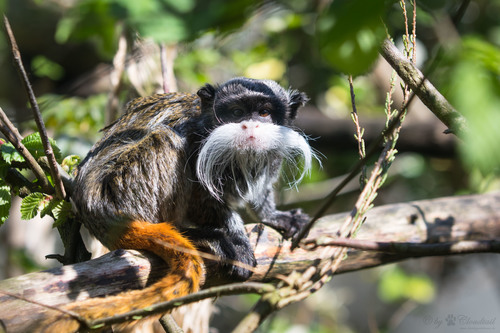
Emperor Tamarin
The Emperor Tamarin, with its regal mustache, is a playful, social primate found in Amazonian rainforests. Agile and tree-dwelling, it thrives in dynamic family groups, contributing to the ecosystem by dispersing seeds and maintaining forest health. Its charming appearance and lively antics make it a rainforest icon.
8-15 years
Lifespan
220.0 - 900.0 g
Weight
Length: 18 - 30 cm
Size
Brown, Grey, Black, White
Color
24 mph
Top Speed
Characteristics
Saguinus imperator, commonly known as the Emperor Tamarin, is a small primate with distinctive long, white mustaches resembling an emperor's mustache. It inhabits the rainforests of the Amazon Basin, primarily in Peru, Brazil, and Bolivia. The species is arboreal, highly social, and known for its playful behavior and agile movements.
Distribution Range of the Emperor Tamarin
Saguinus imperator, commonly known as the Emperor Tamarin, is native to the southwestern Amazon Basin in South America. Its geographical distribution includes countries such as Peru, Brazil, and Bolivia. Specifically, it is found in the regions of the Madre de Dios and Purus Rivers in Peru, the Acre and Rondônia states in Brazil, and the Pando department in Bolivia.
Emperor Tamarin's Habitat
Environmental Conditions
The Emperor Tamarin inhabits tropical and subtropical moist lowland forests, preferring areas with dense vegetation. These regions typically have a warm and humid climate, with significant rainfall throughout the year. The temperature in these forests generally ranges from 20°C to 28°C (68°F to 82°F), and the annual rainfall can exceed 2,000 mm.
Ecological Niche
This primate species is arboreal, living primarily in the upper canopy of the rainforest. It feeds on a diverse diet that includes fruits, flowers, nectar, and small animals such as insects, frogs, and lizards. The Emperor Tamarin plays a role in seed dispersal, contributing to the ecological health and regeneration of its forest habitat. The species is known for its social behavior, often seen in family groups that help in cooperative care of the young.
Copyright @ Nature Style Limited. All Rights Reserved.
 English
English